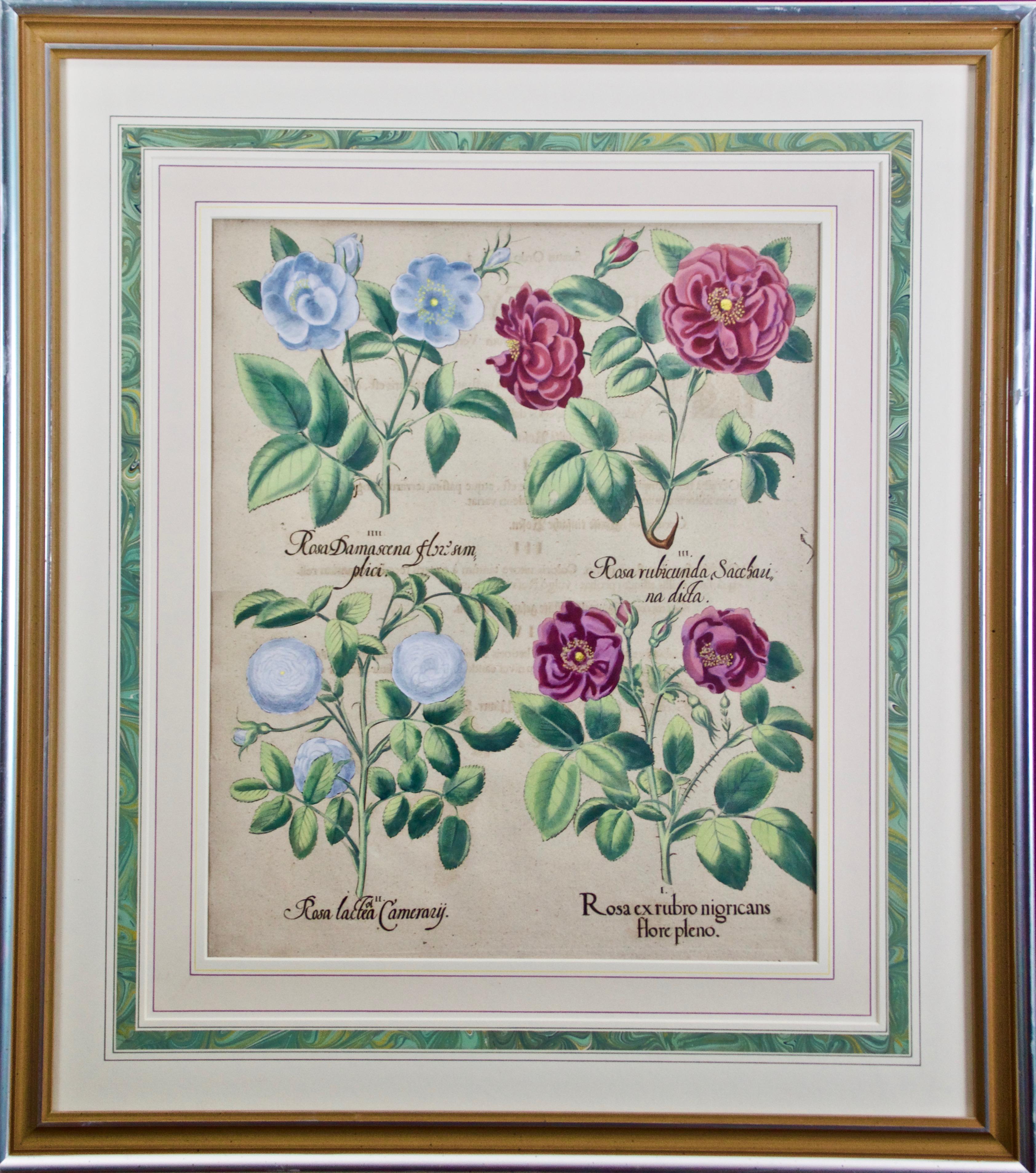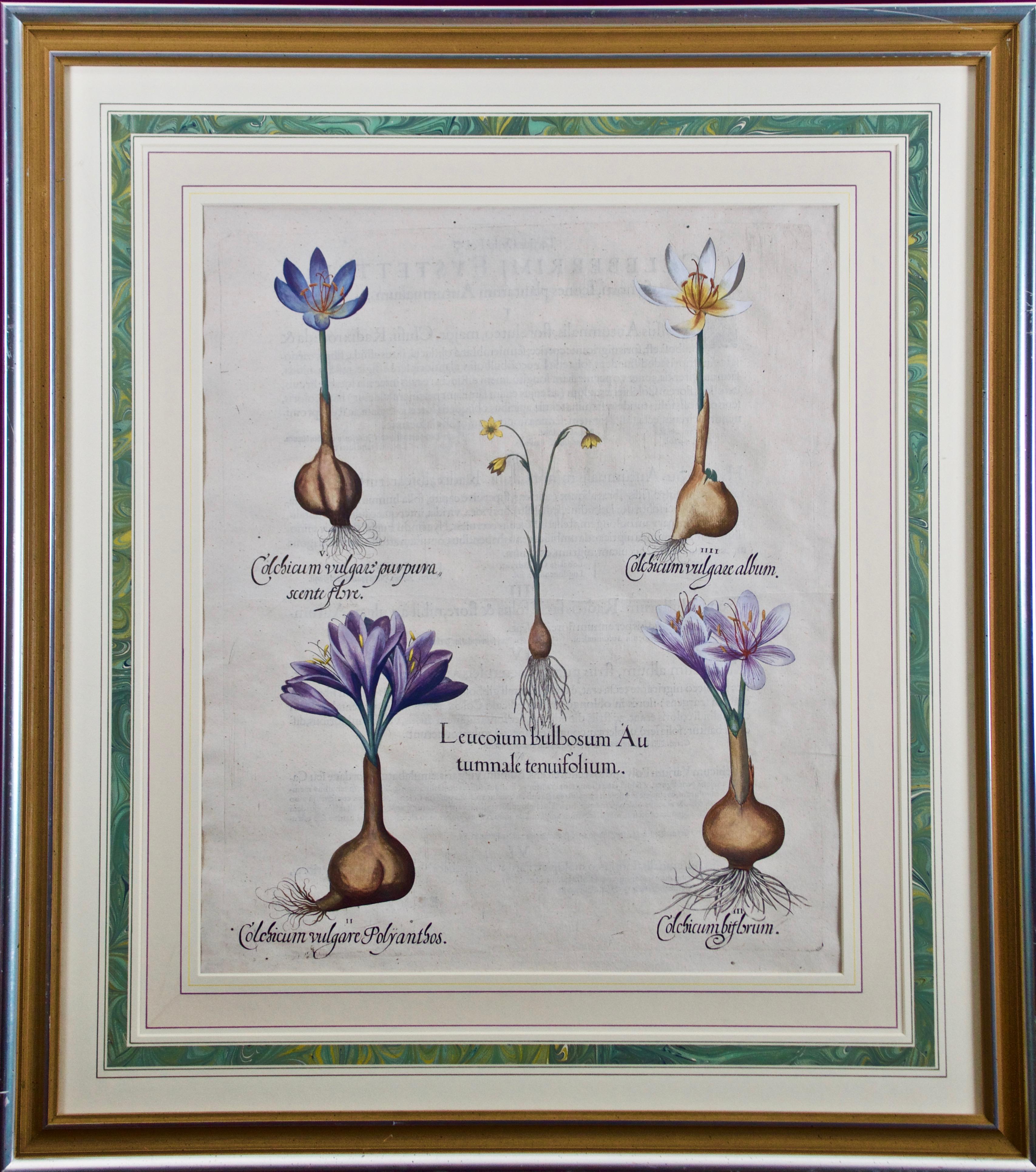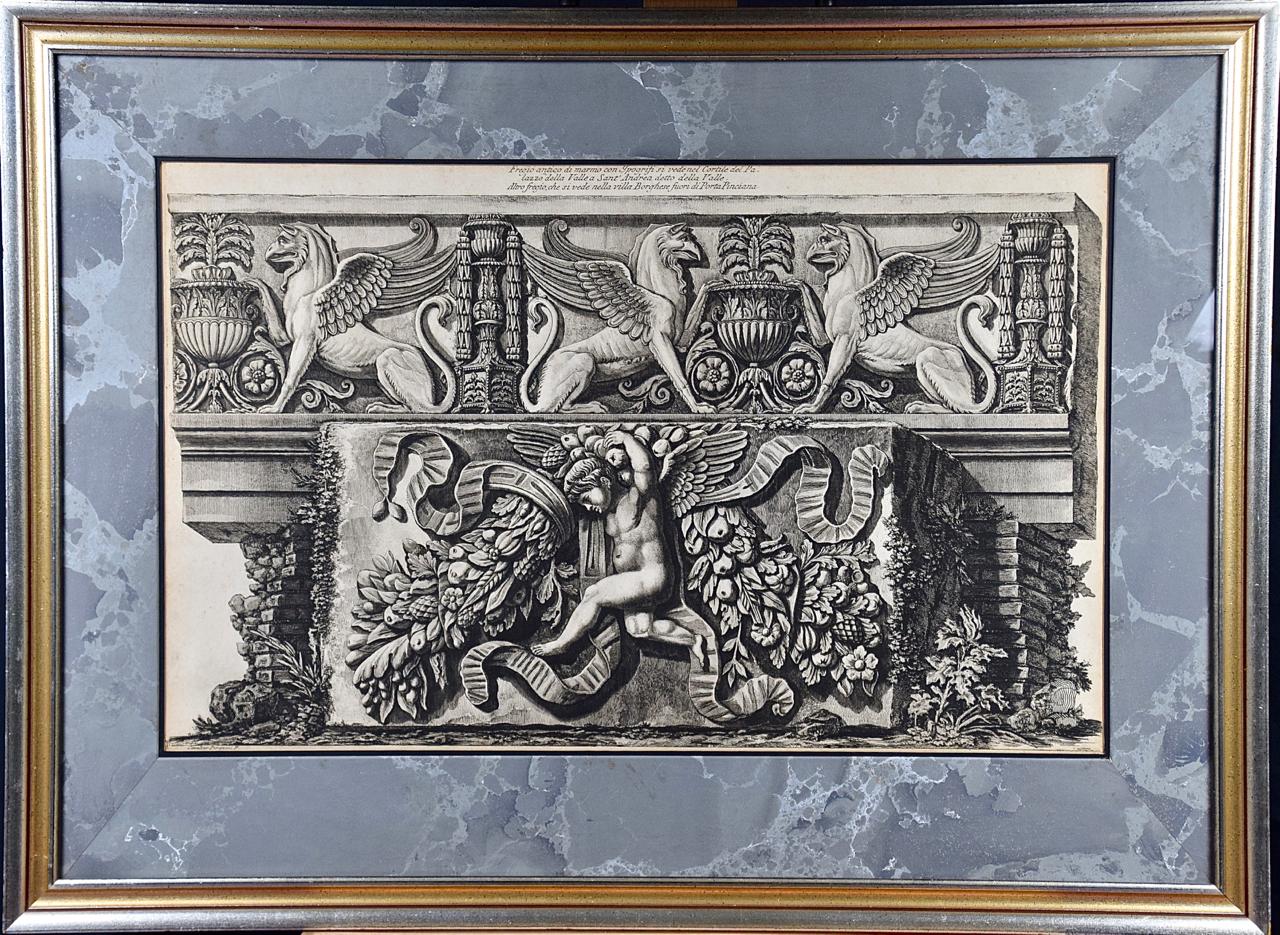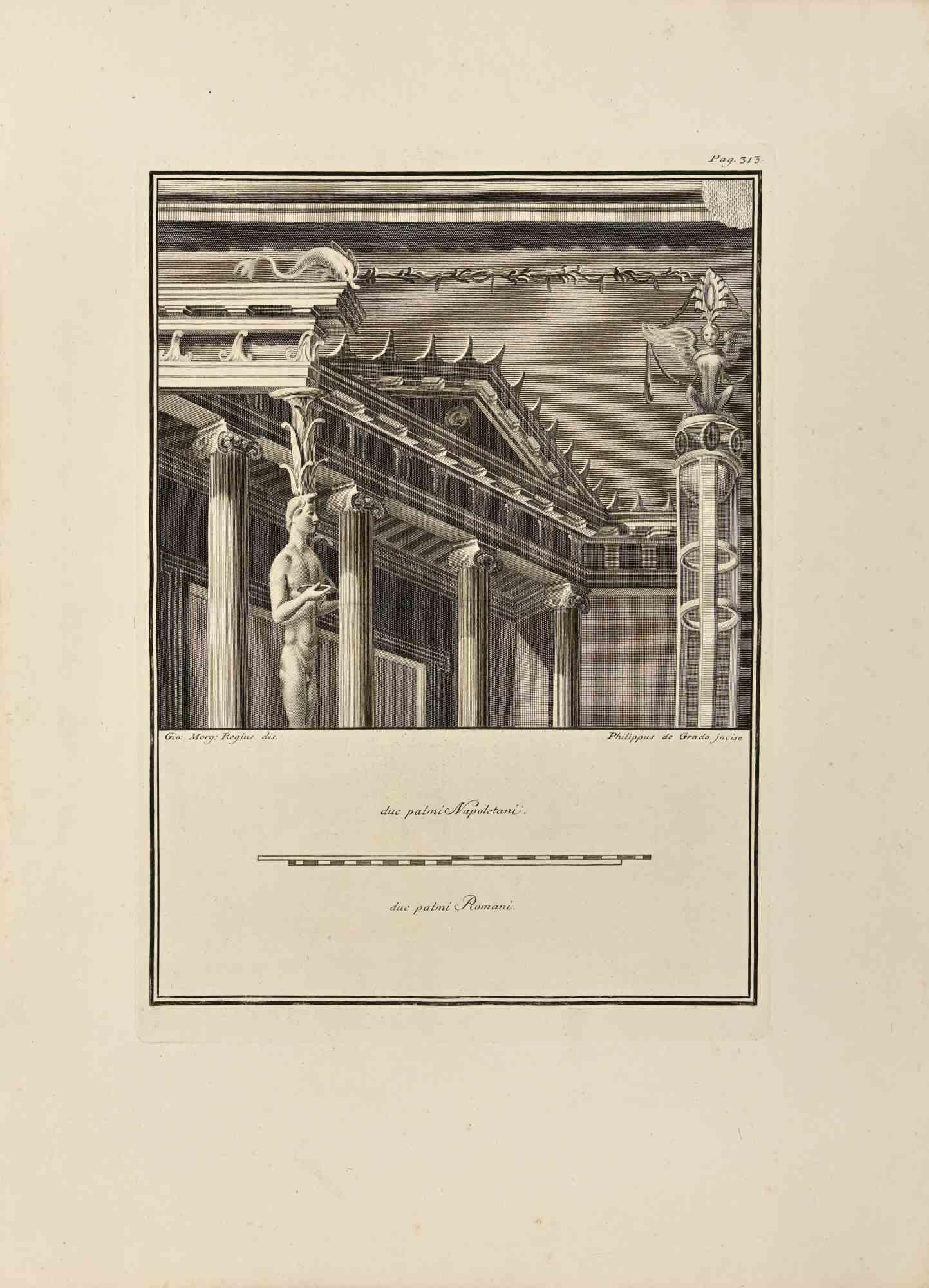Items Similar to Besler Hand Colored Botanical Engraving of Wood Pink & Cottage Pink Flowers
Want more images or videos?
Request additional images or videos from the seller
1 of 8
Basilius BeslerBesler Hand Colored Botanical Engraving of Wood Pink & Cottage Pink Flowers1613
1613
About the Item
A 17th century hand-colored copper plate engraving entitled "Caryophyllus Maior Sylve Strisvarie Gatus" (Wood Pink & Cottage Pink Flowers) from Basilius Besler's landmark work, Hortus Eystettensis (Garden at Eichstatt), first published in 1613 in Eichstatt, Germany near Nuremberg and later in 1640 and 1713.
This engraving is presented in a silver and gold-colored wood frame with a green edge and three elaborate cream-colored French mats; the outer and the inner French mats are accentuated by light gray bands; the middle mat is embellished by a broad decorative marbleized green band. It is glazed with plexiglass. There is text offset, which is frequent with Besler prints, and a central horizontal crease on the right that may be related to the paper manufacture or printing process and a short crease or tear in the left margin. The print is otherwise in very good condition. Provenance: W. Graham Arader Gallery
There are two additional listings of Besler hand-colored botanical engravings that are available for sale. They are identically framed and matted and would make a beautiful display grouping of two or three prints. See Ref. #'s: LU117324265802, LU117324261462. A discount is available for an order of two or more of these or other botanical engravings, depending on the number purchased.
Basilius Besler (1561–1629) was an apothecary and botanist. He was curator of the Willibaldsburg Castle garden of Johann Konrad von Gemmingen, prince bishop of Eichstätt, in Bavaria, who supported Besler's academic and artistic creation and whose funds allowed the purchase of exotic plants from all over Europe. Besler spent 16 years producing drawings of 1084 varieties of plants and flowers in different seasons. These were then engraved on copper plates by master artists, resulting in the 367 beautiful and detailed engravings which comprise Besler's monumental florilegium Hortus Eystettensis, the first large-scale botanical publication.
- Creator:Basilius Besler
- Creation Year:1613
- Dimensions:Height: 31 in (78.74 cm)Width: 27 in (68.58 cm)Depth: 1 in (2.54 cm)
- Medium:
- Movement & Style:
- Period:
- Condition:
- Gallery Location:Alamo, CA
- Reference Number:
About the Seller
5.0
Platinum Seller
These expertly vetted sellers are 1stDibs' most experienced sellers and are rated highest by our customers.
Established in 2011
1stDibs seller since 2019
233 sales on 1stDibs
Typical response time: 1 hour
- ShippingRetrieving quote...Ships From: Alamo, CA
- Return PolicyA return for this item may be initiated within 7 days of delivery.
More From This SellerView All
- Besler Red Roses, "Rosa ex rubro": A 17th C. Hand-colored Botanical EngravingLocated in Alamo, CA"Rosa ex rubro nigricans"; a hand colored copper engraving from Basilius Besler's landmark work, Hortus Eystettensis (Garden at Eichstatt), first published in 1613 in Eichstatt, Germany near Nuremberg and later in 1640 and 1713. This engraving is presented in a glossy silver and matte gold-colored wood frame with a green edge and an elaborate double cream-colored French mats with light mauve bands; each accented by a broad decorative marbleized green band. It is glazed with plexiglass. There is text offset and a very small crease in the left margin, but the print is otherwise in excellent condition. Provenance: W. Graham Arader Gallery...Category
17th Century Old Masters Figurative Prints
MaterialsEngraving
- Besler Autumn Snowflake and Meadow Saffron Flowers: 17th C. Botanical EngravingLocated in Alamo, CAA hand-colored copperplate engraving entitled "Leucoium bulbosum autumnale tenufolium (Autumn Snowflake); Colchicum vulgare Polyanthos; Colchicum biflorum; Colchicum vulgare album; C...Category
17th Century Old Masters Figurative Prints
MaterialsEngraving
- "Limon Straitus Amalphitanus" Ferrari 17th C. Hand Colored Engraving of LemonsBy Giovanni Battista FerrariLocated in Alamo, CAThis 17th century hand-colored engraving of a lemon entitled "Limon Straitus Amalphitanus" is Plate 249 from Giovanni Baptista Ferrari's publication "Hesperides, sive, De Malorum Aur...Category
17th Century Old Masters Figurative Prints
MaterialsEngraving
- Ancient Roman Architectural Frieze: An 18th C. Piranesi EtchingBy Giovanni Battista PiranesiLocated in Alamo, CA"Fregio antico di marmo con Ippogrifi, nel cortile del palazzo della Valle" (Ancient Marble Frieze with Hippogriffs in the Courtyard of The Palace of the Valley) is an etching by Giovanni Battista Piranesi, published in Rome in 1778. It is from Piranesi's monumental work "Vasi, Candelabri, Cippi, Sarcofagi, Tripodi, Lucerne, Ed Ornamenti Antichi", (Vases, candelabra, grave stones...Category
Early 18th Century Old Masters Figurative Prints
MaterialsEtching
- 18th C. Piranesi Fireplace Designs based on Ancient Architectural StylesBy Giovanni Battista PiranesiLocated in Alamo, CAThese two Giovanni Battista Piranesi 18th century etchings of fireplace designs on one sheet is plate 6 from his publication 'Diverse Maniere d'adornare i cammini ed ogni altra parte degli edifizi desunte dall'architettura Egizia, Etrusca, e Greca con un Ragionamento Apologetico in defesa dell'Architettura Egizia, e Toscana, opera del Cavaliere Giambattista Piranesi...Category
Mid-18th Century Old Masters Figurative Prints
MaterialsEtching
- Redoute Hand-colored Engraving of Cactus Flowers "Cactus Peruvianus Cierge"By Pierre-Joseph RedoutéLocated in Alamo, CAThis framed hand-colored stipple engraving entitled "Cactus Peruvianus Cierge du Pérou" by Pierre-Joseph Redouté, Plate 58 from his illustrated publication 'Plantarum Historia Succulentarum ou Histoire des Plantes Grasses', published in Paris in 1799. It depicts a branching limb of a cactus with a beautiful flower. There is a separate detail of the anatomy of a seed with early growth. Redoute was a pioneer of the stipple engraving technique, which he used to create this image. It involves utilizing a series of small dots worked into a copper plate rather than the more common lines. These dots can be made smaller or thicker depending on the degree of opacity the artist intends for various areas of the print. When inked and applied to paper, this allows for a greater portion of the paper to be seen, which accentuates the appearance of luminosity of the subject the artist is creating. Different color inks are used in the printing process, a time consuming technique known as "a la poupee". The engraving is then finished with watercolor to further enhance the beauty and realism of the print subject. This engraving of a flowering cactus is presented in silver-colored ribbed wood frame and a double mat; cream-colored outer mat and heather green inner mat. The frame measures 21.25" high by 17.25" wide by 1.13" deep. The sheet measures 19.88" high by 14" wide. There are wide margins with a few short tears and chips along the the left, right and upper edges, which are all covered by the mat. There are small spots predominantly in the margins, with a few present in the image area. The print is otherwise in very good condition. There is another Redoute flowering cactus listed on 1stdibs, LU117326853392, which is framed and matted identically to this one. The pair would make an attractive display grouping. Pierre-Joseph Redouté (1759-1840), was a painter and botanist originally from Belgium, who pursued his extremely successful artistic career in France. He is well known for his watercolor paintings of roses, lilies and other flowers and their subsequent folio-sized, color stipple engravings. Some believe him to be the greatest botanical illustrator of all time. Redouté was a favorite of the French royal court at the time and of the post French...Category
Late 18th Century Naturalistic Still-life Prints
MaterialsEngraving
You May Also Like
- Temple With Sphinx - Etching by Filippo de Grado - 18th CenturyBy Filippo de GradoLocated in Roma, ITTemple With Sphinx from "Antiquities of Herculaneum" is an etching on paper realized by Filippo De Grado in the 18th Century. Signed on the plate. Good conditions and aged with som...Category
18th Century Old Masters Still-life Prints
MaterialsEtching
- Duck Head Oil Lamp - Etching by Nicola Vanni - 18th CenturyLocated in Roma, ITDuck Head Oil Lamp from "Antiquities of Herculaneum" is an etching on paper realized by Carlo Oraty in the 18th Century. Signed on the plate. Good conditions. The etching belongs ...Category
18th Century Old Masters Figurative Prints
MaterialsEtching
- Ancient Oil Lamps - Etching by Nicola Vanni - 18th CenturyLocated in Roma, ITOil Lamp from "Antiquities of Herculaneum" is an etching on paper realized by Iacomino e Nicola Vanni in the 18th Century. Signed on the plate. Good conditions with some folding. ...Category
18th Century Old Masters Figurative Prints
MaterialsEtching
- Oil Lamp - Etching by Giacomo Casanova - 18th CenturyBy Giacomo CasanovaLocated in Roma, ITOil Lamp from "Antiquities of Herculaneum" is an etching on paper realized by Iacomino e Casanova in the 18th Century. Signed on the plate. Good conditions with some folding. The ...Category
18th Century Old Masters Figurative Prints
MaterialsEtching
- Ancient Still Life 2 - Etching by Nicola Vanni - 18th CenturyLocated in Roma, ITStill Life from "Antiquities of Herculaneum" is an etching on paper realized by Carlo Ceri in the 18th Century. Signed on the plate. Good conditions, aged with some folding. The e...Category
18th Century Old Masters Still-life Prints
MaterialsEtching
- Oil Lamp With Medusa, Cupid - Etching by Francesco Giomignani - 18th CenturyLocated in Roma, ITOil Lamp With Medusa, Cupid and Poseidon from "Antiquities of Herculaneum" is an etching on paper realized by Francesco Giomignani in the 18th Century. Signed on the plate. Good c...Category
18th Century Old Masters Figurative Prints
MaterialsEtching
Recently Viewed
View AllMore Ways To Browse
Antique Pink
Pink Flowers
Pink Wood
Pink And Green Flower
Antique Pink Flowers
Large Pink Flower
Flower Engravings
Old Antique Scales
Old Scales Antique
Old Antique Scale
Old Antique Scales Scales
Engravings Of Flowers
Engravings With Flowers
Copper Engraving Plate
Pink Botanical
Engravings Of Gardens
Large Silver Wood Frames
Hand Colored Botanicals





